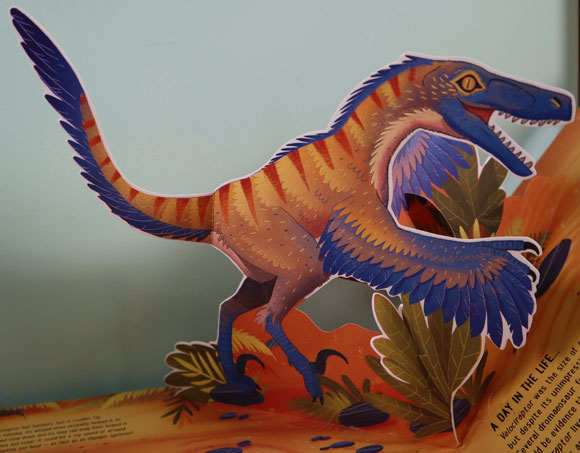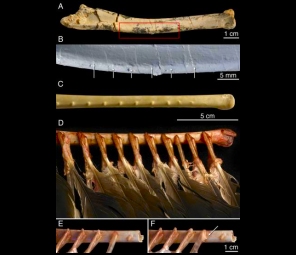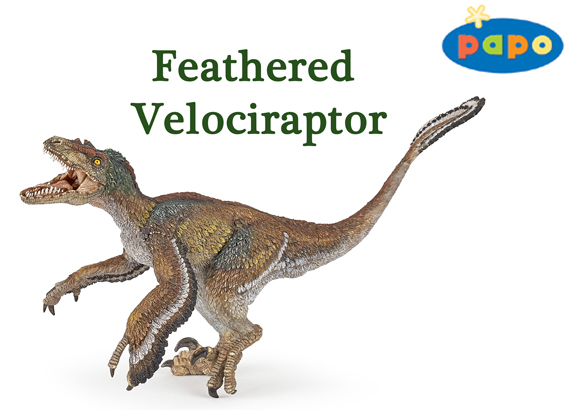American Scientists Claim that Velociraptor was Feathered
Palaeontologists have speculated that many of the Maniraptorians such as Dromaeosaurus and Velociraptor may have been covered in downy feathers. The feathers would help to keep these small, active animals warm and help them to conserve heat. A number of superbly preserved small Theropod fossils have been discovered (mainly in Liaoning province, China), which show traces of proto-feathers and true feathers. Now a group of American scientists claim to have found evidence of feathers on the forearm of a Velociraptor.
Feathered Velociraptors
In research published in the journal “Science” by Alan Turner and Mark Norell of the American museum of Natural History assisted by Peter Makovicky of the Field museum Chicago; evidence for Velociraptor having at least some feathers has been presented.
The team studied the beautifully preserved ulna (forearm) of a Velociraptor found in Ukhaa Tolgod, Mongolia in 1998. The fossil ulna most likely belonged to V. mongoliensis which roamed this part of Asia between 90 – 80 million years old (mya). Most people imagine Velociraptors to be at least two metres tall, but this has to do more with their depiction in the Jurassic Park films than with palaeontology. There were certainly some very large dromaeosaurs around but Velociraptor was only about the size of a turkey, perhaps weighing as little as 15 kilos.
A Feathered Velociraptor

A non-bird dinosaur – a feathered Velociraptor. The book “Prehistoric Pets” demonstrates the link between a budgie and a dinosaur! Picture credit: Everything Dinosaur.
Picture credit: Everything Dinosaur
No fossil of a feathered Velociraptor has yet been found, the sediments in which these animals fossils have been discovered to date are not fine enough to produce such detail and to permit the preservation and fossilisation of such delicate structures. However, the American team claim that the ulna shows signs of regular bumps along its leading edge, these might be “quill knobs”.
Quill knobs are found in many living bird species and are most evident in birds that are strong flyers. Finding evidence of quill knobs on a Velociraptor ulna may confirm that this animal did indeed have feathers.
Quill Knobs
The fossil had six of these bumps about four millimetres apart and the researchers conclude that the bumps would have held the quills of secondary feathers, equivalent to the flight or wing feathers of modern birds. A total of 14 such quill knobs and feathers may have been on the forearm of a Velociraptor, from the size and spacing of the bumps they would have been more than just downy feathers perhaps they were similar to contour (body) feathers on birds which are not designed to assist flight but are downy at the bottom to provide insulation and coloured at the top to provide camouflage or display plumage.
The feathers on the forearm could have been asymmetrical, like the flight feathers of modern birds, but the anatomy of Velociraptor rules out any attempts at flight and the feathers would not have helped much if the animal had wanted to jump further.
What Were the Feathers Used For?
If Velociraptor did have substantial feather adornments on its arms, the question arises what they might have been used for. This could be an encumbrance whilst hunting, as the feathers could have impeded the action of the arms as they grabbed prey – unless of course you take into account the half-moon shaped wrist bones. The curved wrist bone would have permitted sweeping and folding movements of the hands making Velociraptor very effective at grabbing small prey. Perhaps the feathers were used for display purposes, to obtain a mate or deter rivals.
This research adds to the view that dinosaurs did not entirely die out at the end of the Cretaceous, but the feathered, avian dinosaurs (birds) survived and continued to flourish. Today there are still more species of bird in the world than mammals.
Perhaps after all Dinosaurs are survivors…
Close up Velociraptor Ulna and cast compared to Turkey Vulture

Picture credit: Mick Ellison
Image above caption:
(A) View of right ulna of Velociraptor (fossil reference: IGM 100/981).
(B) Detail from cast of red box in (A), with arrows showing six evenly spaced feather quill knobs.
(C) View of right ulna of a turkey vulture (Cathartes).
(D) Same view of Cathartes as in (C) but with soft tissue dissected to reveal placement of the secondary feathers relative to the quill knobs.
(E) Detail of Cathartes, with one quill completely removed to reveal quill knob.
(F) Same view as in (E) but with quill moved to the left to show placement of quill, knob, and follicular ligament. Follicular ligament indicated with arrow.
The Papo Feathered Velociraptor Model
The picture (above) shows a Papo feathered Velociraptor figure, to view the Papo range of prehistoric animal models: Papo Dinosaurs and Prehistoric Animal Models.







Leave A Comment